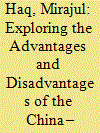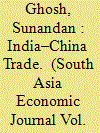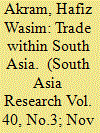| Srl | Item |
| 1 |
ID:
106008


|
|
|
|
|
| Publication |
2011.
|
| Summary/Abstract |
Chinese outward direct investment (ODI) appears to differ from that of advanced economies. Is there a unique China model? By reviewing industry distributions of ODI data for 2003-2009, we found that Chinese ODI was not concentrated in industries that performed well either in exporting or domestically. Statistical analyses also confirmed that traditional variables, such as market size, production cost and legal environment, did not impact Chinese investors' choice of location for ODI. Instead, investors selected places where they could either learn advanced technologies or secure stable commodity supplies. We have tentatively concluded that the main purpose of the China model of ODI has not been to expand production overseas but to strengthen industries at home.
|
|
|
|
|
|
|
|
|
|
|
|
|
|
|
|
| 2 |
ID:
098056


|
|
|
| 3 |
ID:
180637


|
|
|
|
|
| Summary/Abstract |
This paper explores whether the China–Pakistan Free Trade Agreement (FTA), which entered into effect in 2007, has led to advantages or disadvantages for the participating countries. It assesses the gains and losses associated with the agreement rigorously using two different approaches. First, the revealed comparative advantage index is calculated for 10 commodity groups. This identifies the commodity groups in which the participating countries have a comparative advantage. Second, trade creation and trade diversion are estimated for overall imports and for the commodity-group level imports. This analysis provides useful information about the commodity groups in which a particular party to the FTA is experiencing an advantage or a disadvantage. The findings of the study show that China has an advantage in producing capital-intensive goods whereas Pakistan has a comparative advantage in the production of primary and semimanufactured goods. The empirical findings also indicate that, overall, the formation of the bilateral free trade agreement between Pakistan and China enhances trade with member countries as well as with nonparticipating countries.
|
|
|
|
|
|
|
|
|
|
|
|
|
|
|
|
| 4 |
ID:
165368


|
|
|
|
|
| Summary/Abstract |
This article seeks to provide an overview of the evolution and analyses the changing composition of trade between India and China over the period 1983–2017. We find that Chinese exports are almost completely concentrated in manufactures, especially finished equipment goods, whereas Indian exports consist of both agriculture and manufactures and over time have shifted predominantly to intermediate goods. Further, both the countries are exporting those commodities to each other in which they have a revealed comparative advantage, with China’s exports being more diversified. We employ vector error correction estimation and show that China’s exports to India are dependent on India’s household consumption expenditure, while India’ exports to China are correlated to Chinese manufacturing value added. Finally, we calculate the share of each country’s commodity-wise export to the partner in their respective total exports with a view to studying prospects for India–China trade. We conclude that for further trade expansion, diversification is extremely necessary, and Indian exports of inputs to Chinese industries need to change substantially to accommodate the changing nature of China’s industrial structure.
|
|
|
|
|
|
|
|
|
|
|
|
|
|
|
|
| 5 |
ID:
143353


|
|
|
|
|
| Summary/Abstract |
This study examines the bilateral trade relations between New Zealand and India from 1990 to 2014. Using export and import intensity indices and revealed comparative advantage (RCA) indices, it identifies sectors where there is static and dynamic comparative advantage and complementarities. It also examines the extent and movement of intra-industry trade (IIT), using IIT indices, and analyses these indices to consider how trade patterns and relations have changed between 1990 and 2014.
Findings show that trade between New Zealand and India has increased in recent years. The intensity of trade has strengthened, and there has been growth in IIT for a number of industries and product groups. Results also suggest high degree of static and dynamic comparative advantage in a number of product groups. The findings of this study should be relevant to future bilateral trade, economic relations, technology transfer and cultural exchange between New Zealand and India.
|
|
|
|
|
|
|
|
|
|
|
|
|
|
|
|
| 6 |
ID:
174912


|
|
|
|
|
| Summary/Abstract |
This article analyses the causes of low intra-regional trade connections within South Asia, which have remained disappointing despite the long-awaited launch of the South Asian Free Trade Area (SAFTA) on 6 January 2004 in Islamabad. Analysis of World Bank data and other relevant sources for the period 1995–2018 shows that trade among SAFTA members has not increased as significantly as had been hoped. The statistical analysis undertaken confirms what was suspected by many observers, as it shows that the SAFTA countries are not actually natural trading partners. Rather they are often competitors, seeking to export the same product groups. Since this makes the prospects of future substantial increase in mutual trade unlikely, the article concludes with some reflections about how to strengthen regional trade support mechanisms.
|
|
|
|
|
|
|
|
|
|
|
|
|
|
|
|